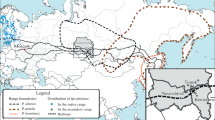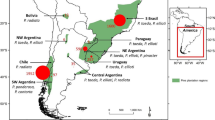Abstract
The small spruce bark beetle Ips amitinus is a widespread species in many European countries that has been actively spreading into Northern Europe in the recent decades. In Russia, I. amitinus is present in the western, northwestern, and northern regions of the European part, with a tendency for range expansion. The species was first recognized in West Siberia in 2019 by characteristic morphological features and molecular genetic analysis. This bark beetle is abundant on Pinus sibirica in Siberian pine forests located near settlements within Tomsk and Kemerovo provinces, and is also sporadically found on the Siberian spruce Picea obovata. It colonizes the upper trunk and branches of standing and windfall trees. In the outbreak foci this bark beetle causes catastrophic drying of Siberian pines, starting from the crown top. This pattern of tree drying was noted for the first time near settlements in Yashkinsky District of Kemerovo Province in 2014, and now outbreak foci of I. amitinus exist in all the Siberian pine forests in this district. The population growth of I. amitinus was probably facilitated by dry and hot summer weather in the southeast of West Siberia during the last decade, in 2011 and 2012, and also by heavy winter snowfalls leaving numerous snapped tree branches which are easily colonized by the pest. In Tomsk Province, the most active outbreak focus of I. amitinus appeared in 2018 in the Siberian pine forest near Luchanovo and Ipatovo, following an outbreak of the Siberian moth Dendrolimus sibiricus. The invasion of I. amitinus in Siberia may increase the degradation rates not only of the gene-reserve Siberian pine forests but also of other dark coniferous stands.
Similar content being viewed by others
References
Baranchikov, Yu.N. and Krivets, S.A., “On the Importance of Expertise in Insect Identification: How the Appearance of a New Aggressive Fir Pest in Siberia was Overlooked,” in Ecology of Southern Siberia and Adjacent Territories. Issue 4 (1), Ed. by Anyushin, V.V. (Khakass State University, Abakan, 2010), pp. 50–52 [in Russian].
Bogdanova, D.A., “Trunk Pests in Coniferous Logging Slash and Their Natural Enemies in the Middle Ob Basin,” in Forest Protection from Insect Pests and Diseases, Ed. by Pleshanov, A.S. (Nauka, Moscow, 1971), pp. 10–12 [in Russian].
Bogdanova, D.A., “Trunk Pests and Their Population Dynamics in Clearings,” in Population Dynamics of Insect Pests in Taiga Forests, Ed. by Isaev, A.S. (Institute of Forest and Timber Resources, Krasnoyarsk, 1976), pp. 112–126 [in Russian].
Brockerhoff, E., Bain, J., Kimberley, M., and Knizek, M., “Interception Frequency of Exotic Bark and Ambrosia Beetles (Coleoptera: Scolytinae) and Relationship with Establishment in New Zealand and Worldwide,” Canadian Journal of Forest Research 36(2), 289–298 (2006).
Cognato, A.I., “Biology, Systematics, and Evolution of Ips,” in Bark Beetles. Biology and Ecology of Native and Invasive Species, Ed. by Vega, F.E. and Hofstetter, R.W. (Elsevier Academic Press, Oxford, 2015), pp. 351–370.
Douglas, H.B., Cognato, A.I., Grebennikov, V., and Savard, K., “Dichotomous and Matrix-Based Keys to the Ips Bark Beetles of the World (Coleoptera: Curculionidae: Scolytinae),” Canadian Journal of Arthropod Identification 38, 1–234 (2019).
Eschen, R., Rigaux, L., Sukovata, L., Vettraino, A.M., Marzano, M., and Gregoire, J.C., “Phytosanitary Inspection of Woody Plants for Planting at European Union Entry Points: a Practical Enquiry,” Biological Invasions 17(8), 2403–2413 (2015).
Flø, D., Krokene, P., and Økland, B., “Importing Deciduous Wood Chips from North America to Northern Europe - the Risk of Introducing Bark- and Wood-Boring Insects,” Scandinavian Journal of Forest Research 29, 77–89 (2014).
Haack, R.A., “Exotic Bark- and Wood-Boring Coleoptera in the United States: Recent Establishments and Interceptions,” Canadian Journal of Forest Research 36(2), 269–288 (2006).
Hu, J., Angeli, S., Schuetz, S., Luo, Y., and Hajek, A., “Ecology and Management of Exotic Beetle Anoplophora glabripennis,” Agricultural and Forest Entomology 11, 359–375 (2009).
Izhevsky, S.S., Nikitsky, N.B., Volkov, O.G., and Dolgin, M.M., An Illustrated Reference Book of Xylophagous Beeles Damaging Forests and Timber in Russia (Grif, Tula, 2005) [in Russian].
Kerchev, I.A., “Species Diversity of Xylophagous Insects in the Southern Taiga Siberian Pine Forests,” in Conceptual and Applied Aspects of Research and Education in Invertebrate Zoology, Ed. by Romanenko, V.N. (Agraf-Press, Tomsk, 2011), pp. 62–66 [in Russian].
Kirkendall, L.R. and Facolli, M., “Bark Beetles and Pinhole Borers (Curculionidae, Scolytinae, Platypodinae) Alien to Europe,” ZooKeys 56, 227–251 (2010).
Kiseleva, E.F., “On Bark Beetles in the Environs of Tomsk,” Izvestiya Tomskogo Universiteta 79(4), 243–246 (1928).
Kiseleva, E.F., “Bark Beetles of Tomsk Province,” Trudy Tomskogo Gosudarstvennogo Universiteta 97, 123–136 (1946).
Kiseleva, E.F., “Pests of the Siberian Pine and Methods of Their Control in Tomsk Province,” Uchenye Zapiski Tomskogo Universiteta 15, 85–100 (1951).
Kiseleva, E.F., “A Review of Insect Pests of Tomsk Province and Methods of Their Control,” Trudy Tomskogo Gosudarstvennogo Universiteta 118, 47–60 (1952).
Kolomiets, N.G., “Current Results of Studying the Siberian Pine Pests and Measures of Their Control,” in Problems of Siberian Pine: Collected Papers on Forest Management in Siberia, Issue 6, Ed. by Krylov, G.V. (USSR Academy of Sciences, Novosibirsk, 1960), pp. 175–183 [in Russian].
Krivets, S.A. and Chemodanov, A.V., “Insect Forest Pests in Tomsk Province,” in Entomological Studies in Siberia, Vol. 4, Ed. by Baranchikov, Yu.N. (Sukachev Institute of Forest Studies, Krasnoyarsk, 2005), pp. 98–118 [in Russian].
Krivets, S.A. and Vysotina, S.V., “An Eco-Faunistic Review of Trunk Damaging Beetles (Insecta, Coleoptera) in Coniferous Forests of the Ket River Basin,” Vestnik Tomskogo Gosudarstvennogo Universiteta. Seriya Biologiya 3(15), 88–103 (2011).
Krivolutskaya, G.O., Cryptic Trunk Pests in West Siberian Dark Coniferous Forests Damaged by the Siberian Moth (Nauka, Moscow, 1965) [in Russian].
Krivolutskaya, G.O., “An Eco-Geographic Characteristic of the Bark Beetle Fauna (Coleoptera, Scolytidae) of North Asia,” Entomologicheskoe Obozrenie 62(2), 287–301 (1983).
Liebhold, A.M., Brockerhoff, E.G., Garrett, L.J., Parke, J., and Britton, K.O., “Live Plant Imports: the Major Pathways for Forest Insect and Pathogen Invasions of the US,” Frontiers in Ecology and the Environment 10(3), 135–143 (2012).
Mandelshtam, M.Yu., “Current Status of Ips amitinus Eichh. (Coleoptera, Scolytidae) in North-West Russia,” Entomologica Fennica 10(1), 29–34 (1999).
Mandelshtam, M.Yu. and Musolin, D.L., “Bark Beetle Ips amitinus (Eichhoff, 1872) (Coleoptera: Curculionidae: Scolytinae) continues to expand its range in North-Western and Northern Russia,” in Monitoring and Biological Control Methods of Woody Plant Pests and Pathogens: from Theory to Practice, Ed. by Baranchikov, Yu.N. (Institute of Forest, Krasnoyarsk, 2016), pp. 129–130 [in Russian].
McCullough, D.G., Work, T.T., Cavey, J.F., Liebhold, A., and Marshall, D., “Interceptions of Nonindigenous Plant Pests at US Ports of Entry and Border Crossings over a 17-Year Period,” Biological Invasions 8, 611–630 (2006).
Økland, B., Flø, D., Schroeder, M., Zach, P., Cocos, D., Martkainen, P., Siitonen, Ju., Mandelshtam, M.Yu., Musolin, D.L., Neuvonen, S., Vakula, J., Nikolov, Ch., Lindelöw, Å., and Voolma, K., “Range Expansion of the Small Bark Beetle Ips amitinus: a Newcomer in Northern Europe,” Agricultural and Forest Entomology, 21(3), 286–298 (2019). https://doi.org/10.1111/afe.12331.
Orlova-Bienkowskaja, M.Ja., “Is It Possible to Distinguish Alien Species of Beetles (Coleoptera) from Native Ones?” Entomologicheskoe Obozrenie 95(2), 71–89 (2016) [Entomological Review 96 (3), 318–331 (2016)].
Piel, F., Gilbert, M., De Canniere, C., and Gregoire, J.C., “Coniferous Round Wood Imports from Russia and Baltic Countries to Belgium. A Pathway Analysis for Assessing Risks of Exotic Pest Insect Introductions,” Diversity and Distributions 14, 318–328 (2008).
Pimentel, D., Zuniga, R., and Morrison, D., “Update on the Environmental and Economic Costs Associated with Alien-Invasive Species in the United States,” Ecological Economics 52(3), 273–288 (2005).
Rassati, D., Faccoli, M., Petrucco Toffolo, E., Battisti, A., and Marini, L., “Improving the Early Detection of Alien Woodboring Beetles in Ports and Surrounding Forests,” Journal of Applied Ecology 52(1), 50–58 (2015).
Roques, A., Auger-Rozenberg, M.A., Blackburn, T.M., Garnas, J., Pyšek, P., Rabitsch, W., Richardson, D.M., Wingfield, M.J., Liebhold, A.M., and Duncan, R.P., “Temporal and Interspecific Variation in Rates of Spread for Insect Species Invading Europe during the Last 200 Years,” Biological Invasions 18(4), 907–920 (2016).
Skorokhodov, S.N., “Save the Neighboring Stone Pine Woods,” Yashkinsky Vestnik, No. 37 (8564), 13.09.2017.
Stark, V.N., “On the Fauna of Bark Beetles of Bryansk Province,” Zashchita Rastenii 3, 330–339 (1926).
Stark, V.N., Bark Beetles (Fauna of the USSR, Vol. 31: Coleoptera), Ed. by Stackelberg, A.A. (USSR Academy of Sciences, Moscow, Leningrad, 1952) [in Russian].
Voolma, K., Mandelshtam, M.Yu., Shcherbakov, A.N., Yakovlev, E.B., Õunap, H., Süda, I., Popovichev, B.G., Sharapa, T.V., Galasjeva, T.V., Khairetdinov, R.R., Lipatkin, V.A., and Mozolevskaya, E.G., “Distribution and Spread of Bark-Beetles (Coleoptera: Scolytidae) around the Gulf of Finland: A Comparative Study with Note on Rare Species of Estonia, Finland and North-Western Russia,” Entomologica Fennica 15(4), 198–210 (2004).
Yanovskij, V.M., “Annotated List of Scolytids (Coleoptera, Scolytidae) of North Asia,” Entomologicheskoe Obozrenie 78(2), 327–359 (1999) [Entomological Review 79 (5), 493–522 (1999)].
Acknowledgments
We thank our colleagues from Tomsk Forestry (Forestry Department of Tomsk Province), Tomsk Branch of the All-Russian Center for Plant Quarantine, Tomsk Forest Protection Center, and also S.N. Skorokhodov (Laboratory of Ecosystem Dynamics and Stability, Institute of Monitoring of Climatic and Ecological Systems) for help with material collection.
Funding
This paper was prepared using the resources of the Shared Equipment Center of St. Petersburg State Forest Technical University “Renewable resources, energy sources, new materials and biotechnologies (SPbFTU)” (project 2019-0420). The work of M.Yu. Mandelshtam was financially supported by the Russian Foundation for Basic Research (project 17-04-00360a).
Author information
Authors and Affiliations
Corresponding author
Additional information
Russian Text © The Author(s), 2019, published in Entomologicheskoe Obozrenie, 2019, Vol. 98, No. 3, pp. 592–599.
Rights and permissions
About this article
Cite this article
Kerchev, I.A., Mandelshtam, M.Y., Krivets, S.A. et al. Small Spruce Bark Beetle Ips amitinus (Eichhoff, 1872) (Coleoptera, Curculionidae: Scolytinae): a New Alien Species in West Siberia. Entmol. Rev. 99, 639–644 (2019). https://doi.org/10.1134/S0013873819050075
Received:
Revised:
Accepted:
Published:
Issue Date:
DOI: https://doi.org/10.1134/S0013873819050075




